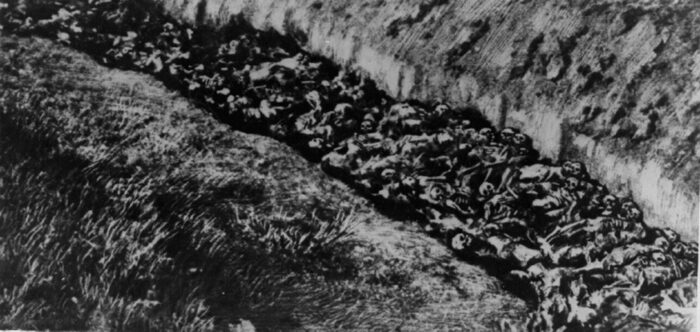Kharkov
The north-western Ukrainian city of Kharkov (today spelled Kharkiv) had some 700,000 inhabitants, when it was occupied by German forces in late October 1941. The city changed hands three times in 1943, and was ultimately reconquered by the Soviets in late August 1943.
In a repeat performance of what had been staged earlier in Krasnodar, the Soviets prepared another Stalinist show trial, this time against three captured German soldiers and one local Soviet citizen accused of having collaborated with the Germans. The charges were, among other things, that these defendants had been involved in hanging, shooting and asphyxiating “many tens of thousands” Soviet civilians. The latter was said to have been committed by the use of so-called gas vans.
The trial itself took place between 15 and 18 December 1943. The conditions of the Kharkov Trial were basically identical to that of the Krasnodar Trial. It was a stage show following a preordained script, where every actor played a theatric role. The defendants had been abused and tortured so much that, during the trial, they were either completely apathetic, or they enthusiastically embraced their charges. Defense lawyers were additional prosecutors.
In addition to teaching all Soviet citizens a lesson that collaborating with the Germans will be punished severely, this show trial had the additional purpose of portraying the Germans as the much worse butchers than the Soviets. After the German discovery and propagandistic exploitation of the mass graves of Soviet mass-murder victims at Katyn and Vinnitsa earlier that year, the Soviets felt a keen need to get back at the Germans.
While the prosecution claimed only some 7,000 civilian victims in total for Krasnodar, that death toll was significantly increased during the Kharkov Trial to 30,000. As during the Krasnodar Trial, here, too, the prosecution and its coached witnesses asserted that the asphyxiation occurred in trucks with carbon monoxide emitted by Diesel engines. However, that exhaust gas is unsuited for executions due to its lack of toxicity.
Just as in the case of Krasnodar, the prosecution repeated its claim that they had exhumed and forensically investigated the remains of the victims extracted from mass graves. They claimed that their forensic experts had established the presence of carbon monoxide in the victims’ blood. However, after a year or two of decomposing in mass graves, it can be safely ruled out that anyone was able to establish anything about remnants of carbon monoxide in severely rotten tissue samples.
The three German defendants were groomed to make all kinds of absurd statements. Among them, what Hitler supposedly ordered (how would they know?), and how gassings at Auschwitz were being carried out: by suddenly switching showers spouting water to emit gas instead. This preposterous nonsense demonstrates once more the ludicrous nature of these Stalinist show trials.
Kharkov is mentioned only once in the reports by the Einsatzgruppen. In mid-December 1941, 305 Jews are said to have been executed in this city by Einsatzgruppe C. In addition to this, Jews in Kharkov are mentioned in three Einsatzgruppen reports of early 1942. However, these only report about the registration of all Jews, the preparation of new accommodations for them, and their relocation to these new accommodations.
Two images exist claiming to be photos of a mass grave near Kharkov allegedly taken by the Soviets during some exhumation work. However, these are clearly drawings. Also, if those bodies were in the process of getting exhumed, there would be soil among and on top of some of the bodies. However, the bodies visible in these images have been drawn with no soil anywhere. (See the illustration.)

There is also a certainly genuine film footage showing the exhumation work of a Soviet commission at a mass grave of maybe a few hundred bodies. However, orthodox sources contradict one another as to what this footage shows. Most of them insist that these are victims at Babi Yar, although the visible landscape shows no resemblance with that ravine near Kiev. Some close-up frames suggest that these victims wore uniforms when killed, hence may simply be battle casualties or deceased PoWs.
Therefore, just as in the case of Krasnodar, there is no independent evidence that could reliably verify the inflated death-toll claims made by the Soviets regarding Kharkov.
(For more details, see the entry on gas vans, as well as Bourtman 2008; Alvarez 2023, pp. 122-129; Mattogno 2022c, pp. 725-737.)

You need to be a registered user, logged into your account, and your comment must comply with our Acceptable Use Policy, for your comment to get published. (Click here to log in or register.)